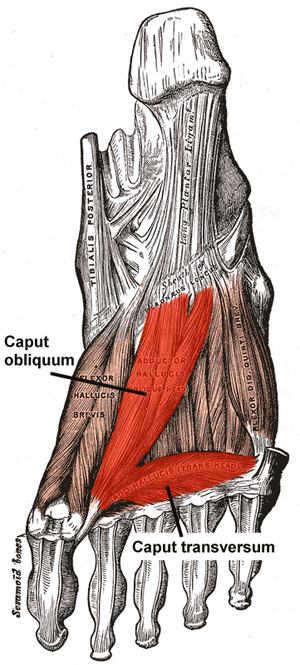Adductor Hallucis
Original Editor - User Name
Top Contributors - Patti Cavaleri, Kalyani Yajnanarayan, Vidya Acharya and Wendy Snyders
Description[edit | edit source]
Adductor hallucis muscle is an intrinsic two-headed muscle in the sole of the foot. It is 1 of 3 muscles in the third layer of plantar foot muscles. The other muscles of the third layer of plantar foot muscles are flexor hallucis brevis and flexor digiti minimi brevis[1].
Origin[edit | edit source]
Muscle originates by two muscular heads, the transverse and oblique heads. The oblique head originates from the bases of the second, third and forth metatarsals. The transverse head originates from the plantar ligaments of metatarsophalangeal (MTP) joints[1].
Insertion[edit | edit source]
The two heads of the adductor hallucis join together before inserting distally on the lateral side of the base of the proximal phalanx of the first digit[1]. The distal attachment point joins with the flexor hallucis brevis tendon on the fibular sesamoid as well[2].
Nerve[edit | edit source]
The deep branch of the lateral plantar nerve (S2, S3) from the tibial nerve.
Artery[edit | edit source]
Lateral Plantar Artery
Function[edit | edit source]
Adducts and flexes the great toe at the metatarsophalangeal joint. Supports the transverse arch.
It may be most active during push-off of the gait cycle by stabilizing the transverse arch of the foot and metatarsal heads[1].
Clinical relevance[edit | edit source]
Supports the longitudinal and transverse arch of the foot. A key intrinsic muscle of the foot.
Due to the pull on the lateral aspect of the first digit, the adductor hallucis may contribute to hallux valgus deformities[2]. Surgeons have reported that a full surgical release of the distal tendon of the adductor hallucis during bunionectomies can lead to hallux varus[2].
Assessment[edit | edit source]
Adductor hallucis muscle testing can be done by resisting flexion and adduction of the first digit.
Treatment[edit | edit source]
A traumatic rupture of the adductor hallucis is uncommon but can also lead to hallux varus deformities. Barp et al reported good surgical outcome in a case study of a 33 year-old male who underwent surgical fixation of the adductor hallucis tendon following a traumatic rupture while pivoting on a barefoot[4]. Other treatments of the adductor hallucis are not well documented.
Resources[edit | edit source]
- ↑ 1.0 1.1 1.2 1.3 Moore KL, Dalley AF, R. AAM, Moore KL. lower limb. In: Moore clinically oriented anatomy. Philadelphia, PA: Wolters Kluwer Health/Lippincott Williams & Wilkins; 2014. p. 610–5.
- ↑ 2.0 2.1 2.2 Owens S, Thordarson DB. The adductor hallucis revisited. Foot Ankle Int. 2001 Mar;22(3):186-91.
- ↑ Blackriver & Bootsma Education. Manual Muscle Test and Lengthening - Flexor Hallucis Brevis & Flexor Digiti Min. & Adductor Hallucis. Available from:https://www.youtube.com/watch?v=22zk-EzctQ4 [last accessed 22/1/2022]
- ↑ Barp EA, Temple EW, Hall JL, Smith HL. Treatment of Hallux Varus After Traumatic Adductor Hallucis Tendon Rupture. J Foot Ankle Surg. 2018 Mar-Apr;57(2):418-420.







